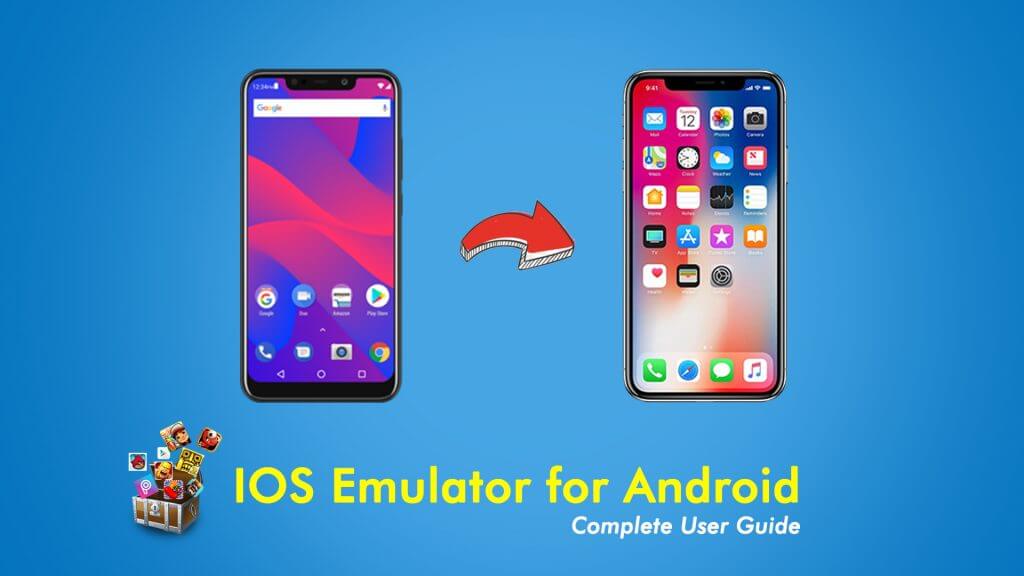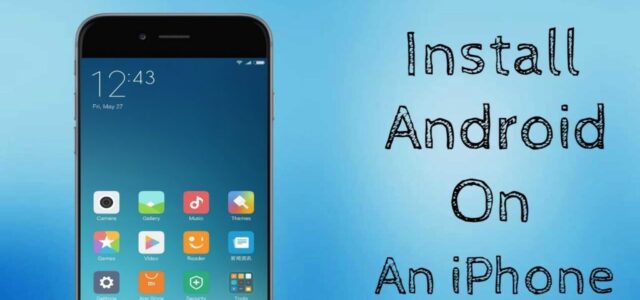Get Android apps on a PC is easy; fire up Bluestacks, set it up, and get using your Android apps. While it’s that easy on PC, it may not be that easy on iPhones. But, can you find how to install Android apps on iPhone?
iPhones run the iOS operating system, a totally different one from Android. What runs on Android shouldn’t run on iOS, right?
Not exactly. Apple Macs and Macbooks running macOS can emulate iOS apps, while the new Windows 11 will reportedly emulate Android apps.
If these systems can do it, an iPhone can do it too. In this article, we’ll analyze the feasibility of installing and running Android apps on an iOS device.
Post Content
Why Native Android Apps are Unsupported On iOS
You might be wondering: why can’t I just download an APK off APKPure and sideload it onto this new pretty little iMachine?
Sorry brother, you can’t.
Firstly, Apple isn’t exactly into that kind of Android sideloading thing. Even if you get the application package for an iPhone, you can’t just install it directly as you do on Android.
Secondly, iOS and Android are two totally different operating systems, running totally different runtime environments that read totally different file types.
Heck, you can’t even transfer files from an iPhone to an Android phone via Bluetooth!
One more thing; iPhone hardware is created to exclusively run iOS apps. The processor in the iPhone was custom-made by Apple to run Apple software as seamlessly as anything can.
If you try to throw an Android app into a system designed entirely for iOS, you will be surprised by the subpar performance.
This doesn’t imply that the phone is bad. The lack of cross-platform support is what will bring about some unfriendly features, making the experience appalling.
While everything in this section must have made you think that it’s impossible to run Android apps on iPhones, that’s actually not the case.
To be clear, you can run Android apps on iPhones (somehow), and I’ll show you exactly how you can do that in a moment.

How to Install Android Apps on iPhone
If we’ll judge by everything that I’ve said in this article, you’ll easily conclude that it’s impossible to run Android apps on an iPhone.
However, that’s far from being the case. All thanks to some strategies, there are ways by which you can run Android directly on an iOS device without having to patronize Samsung.
Here, I’ll examine each of these strategies, so you can choose your favorite way to get your favorite Android apps directly on your iPhone or iPod touch.
Method 1: Using iDroid
This isn’t a Metal Gear spoiler; it is software that can transform your iPhone into an Android device (kind of).
iDroid lets you run Android on your iPhone, making it possible to sideload apps like you would on a regular Android phone.
However, this isn’t one of the ‘jailbreaking unnecessary’ iPhone tutorials. You need to jailbreak your iPhone to make iDroid work.
Jailbreaking can be a tedious process, so I won’t be covering the processes here. However, if you have a jailbroken iPhone, here are the steps required to install iDroid and get Android running on Apple’s iOS.
-
Install Bootlace
On your jailbroken iPhone, you’ll need to install the Cydia app store to install Bootlace.
Bootlace won’t install automatically when you install Cydia, you have to alter the Sources to add the Bootlace repository before Bootlace will be available to install.
After installing Bootlace, you need to let it patch the kernel. This might take a couple of minutes and multiple reboots if you can wait through.
-
Install OpeniBoot
When Bootlace is done patching your kernel, you can install OpeniBoot from Bootlace. Open Bootlace and select OpeniBoot to install it on your iPhone.
-
Install iDroid
When you’ve installed Bootlace and OpeniBoot, you can proceed to install iDroid. You should also install iDroid only through Bootlace. Obviously, iDroid is unavailable in the App Store.
iDroid will take a couple of minutes to install, as you’re installing an operating system (kind of). You may want to plug in your iPhone and get something else to do to while away time.
-
Boot into Android
After installing iDroid, you’re ready to run Android on your iPhone. To boot into Android, launch Bootlace and select Quickboot.
An Android icon will appear. Tap on this Android icon to reboot your iPhone into a new Android environment.
Note that iDroid may not work on the latest iPhones. This is because the hack requires specific kinds of jailbreak to make it work.
As most of the latest iPhones are the results of Apple’s very best advancements in cybersecurity, it might be difficult, if not impossible to use these jailbreaking methods on the iPhones.
Method 2: Using An emulator
If you want to run iOS alongside Android, using an emulator might just be your best bet.
An emulator lets you install a version of Android on your iPhone. However, this doesn’t tamper with your existing OS, and you only run it whenever you want.
Furthermore, most mainstream emulators don’t require you to jailbreak your iPhone, making it easier to install the emulators on most of the recent iPhones.
However, most of these emulators are unavailable in the App Store. If you want to run an Android emulator on your iPhone, you should be ready to tinker with some settings on your iPhone.
Here are some of the best Android emulators for iOS, and why you should consider them for your Android on iOS project.
-
Alien Dalvik Emulator
Android emulator on iOS is almost synonymous with Alien Dalvik. It is a free Android emulator that is available on almost iDevice.
The Alien Dalvik emulator was created by Myriad to bring Android to iPhones, and it seems to have delivered well on its promise.
If you’ll like to use Alien Dalvik on your iPhone, you cannot find it on the App Store. You must install the Cydia app store to get to use the emulator.
Installing Alien Dalvik emulator involves modifying some settings from the emulator and iPhone settings.
If you don’t want to go through the tedious process of patching your iPhone’s kernel and installing all kinds of untrusted apps, you can simply go with Dalvik.
-
iAndroid
if you think Alien Dalvik is unintuitive, you might want to try out iAndroid. iAndroid is strikingly similar to Alien Dalvik in functionality, and it’s also unavailable on the iOS App Store.
If you can figure out how to install Cydia without a jailbreak, you can as well use iAndroid without jailbreaking your iPhone.
iAndroid is compatible with almost every iPhone from the iPhone 4, and it provides a compelling interface that will make you use the app more often than you’ll need it.
You can’t rank iAndroid higher than Alien Dalvik emulator, but it’s certainly not far behind. What’s more, iAndroid is also a free-for-life app, no ongoing subscriptions are needed.
iAndroid also excels at bringing all of your iDevices together. You can install the emulator on your iPads, iPhones, and compatible iPod Touch devices running iOS 7 or higher.
Method 3: Screen Mirroring
While screen mirroring doesn’t allow you to install Android apps on an iPhone, it gives you the feel of Android on iOS, as you’re essentially seeing Android run on iOS.
When you use a screen mirroring app on iOS, everything you do on your Android phone appears on the iPhone’s screen, duplicating the screen.
Screen mirroring iOS to Android has a requirement that’s nonexistent on other methods in this guide; owning an Android phone.
There is no way you can mirror your Android’s screen to iOS without owning an Android phone. So, this is only a feasible solution when you have an Android phone, an iPhone, and you’ll like to run Android apps on the iPhone.
Here are some of the most popular screen mirroring software that has worked reliably over the years.
-
Apowermirror
There isn’t really a reason why you’ll want to use an app other than Apowermirror for mirroring your Android’s screen to iOS.
Apowermirror requires no jailbreaking to run, and no feature is hidden for users with a jailbroken iPhone.
It boasts of an intuitive interface and a startup guide that helps you to complete the pairing between the iPhone and the Android.
If you ever want to get stuck, there are so many official tutorials out there teaching how to use the app.
-
Screen Mirror
If mainstream apps aren’t your thing, you might prefer Screen Mirror over the more popular Apowermirror.
Screen Mirror works over a browser, so you don’t need to download the iOS app (unlike Apowermirror).
When you download and run the app, you will get a browser address that you can enter on your iPhone’s browser to start mirroring the Android experience.
And it’s free.
MORE ARTICLES
Best Laptops with Thunderbolt 3 – Comprehensive List
Android Emulator for iOS (iOS Android Emulator, Android Emulator iPhone)
How to Unlock Someone on Venmo
Laptop Speakers Not Working – How To Fix It
Computer Not Recognizing Headphones Windows 7, 10
Dell plugged in Not Charging Windows 10 -One Time Solution
Best Processors for Mobile – Companies With Best Processors
Bluestacks for iPhone (Bluestacks for iOS)
Conclusion
Since Apple iPhones are fundamentally designed to run only iOS apps, trying to get Android apps to work on them becomes a challenge.
Challenges are usually difficult, and almost never impossible. That’s also the case with this, as you can get your iPhone to run Android apps almost perfectly.
This article outlines three different methods by which you can run Android apps right on your iPhone, without paying a premium for another phone.

